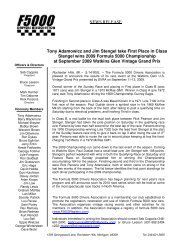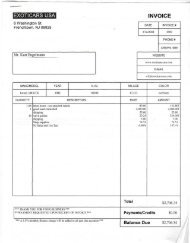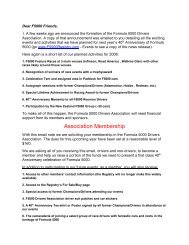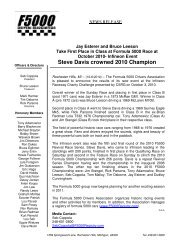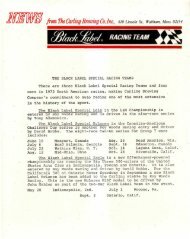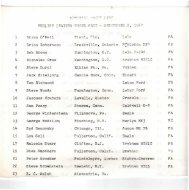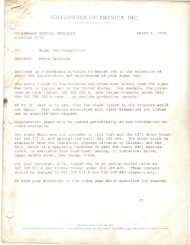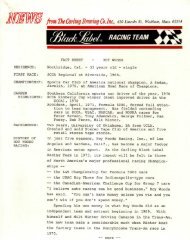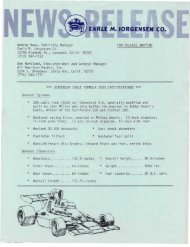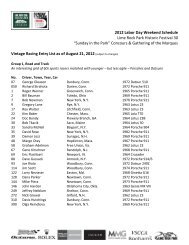1975 rules governing F5000 - My Formula 5000
1975 rules governing F5000 - My Formula 5000
1975 rules governing F5000 - My Formula 5000
You also want an ePaper? Increase the reach of your titles
YUMPU automatically turns print PDFs into web optimized ePapers that Google loves.
FORmillR 50DD<br />
tHnmpionsHip<br />
usnc<br />
Supplementary<br />
Regulations<br />
General Information<br />
Schedule
1974 USAC/SCCA FORMULA <strong>5000</strong> CHAMPIONSHIP<br />
A Series of Races for USAC Championship and <strong>Formula</strong> <strong>5000</strong> Racing Cars<br />
1. The 1974 USAC/SCCA <strong>Formula</strong> <strong>5000</strong> Championship<br />
events are listed as Full International Events on the FIA<br />
International Calendar. The events are conducted under<br />
these Supplementary Regulations.<br />
2. The administrator of the Series and the sanctioning<br />
authority for United States events is the United States<br />
Auto Club (USAC) and the Sports Car Club of America,<br />
Inc. (SCCA). The sanctioning authority for Canadian<br />
events is the Canadian Automobile Sport Clubs (CASC).<br />
3. USAC/SCCA Joint Championship Series<br />
The United States Auto Club and the Sports Car Club of<br />
America have agreed to jointly sanction and conduct the<br />
series of racing events counting towards the <strong>Formula</strong> <strong>5000</strong><br />
Championship. Following the last event of the Series, the<br />
Series Champion, whether USAC or SCCA, will receive<br />
the <strong>Formula</strong> <strong>5000</strong> Championship trophy.<br />
Events comprising the 1974 co-sanctioned Series are:<br />
June 2<br />
June 15<br />
July 14<br />
July 28<br />
Sept. 1<br />
Oct. 13<br />
Oct. 27<br />
4. Championship Points<br />
Mid-Ohio Sports Car Course, Lexington, Ohio<br />
Mosport Park, Bowmanville, Ontario, Canada<br />
Watkins Glen GP Circuit, Watkins Glen, N.Y.<br />
Road America, Elkhart Lake, Wis.<br />
Ontario Motor Speedway, Ontario, Cal.<br />
Laguna Seca Raceway, Monterey, Cal.<br />
Riverside Int'l. Raceway, Riverside, Cal.<br />
USAC and SCCA shall award Series Championship points<br />
and maintain the point standings. Points shall be awarded<br />
to drivers based upon their ifinishing positions in the<br />
feature race of each event as follows:<br />
First<br />
Second<br />
Third<br />
Fourth<br />
Fifth<br />
20 Points<br />
15 Points<br />
12 Points<br />
10 Points<br />
8 Points<br />
Sixth<br />
Seventh<br />
Eighth<br />
Ninth<br />
Tenth<br />
6 Points<br />
4 Points<br />
3 Points<br />
2 Points<br />
1 Point<br />
NOTE: USAC CHAMPIONSHIP DIVISION POINTS<br />
WILL NOT BE AWARDED IN CONNECTION WITH<br />
ANY EVENTS IN THIS SERIES.<br />
The Championship will be awarded to the driver accumulating<br />
the most points.<br />
In case of ties in final point standings, they will be<br />
resolved according to each driver's record of first place<br />
finishes, then, if necessary, the number of second place<br />
finishes, then, if necessary, the number of third place<br />
finishes, and so on down to tenth position.<br />
If more than one driver drives a given automobile in any<br />
one race, neither driver shall receive Championship points<br />
for that race. The entrant, however, will receive any prize<br />
money due for that race.<br />
5. Entries<br />
The entry form is to be filled out for each event and sent<br />
to the Organizer according to the instructions on the<br />
entry form. The duplicate entry application must be filled<br />
out and sent to USAC.<br />
THE ENTRY FEE FOR EACH EVENT IS $200 FOR<br />
EACH CAR ENTERED AND MUST BE SUBMITTED TO<br />
USAC WITH THE ENTRY FORM.<br />
ENTRIES POSTMARKED AFTER THE ENTRY DEAD-<br />
LINE MUST BE ACCOMPANIED BY AN ADDITIONAL<br />
FEE OF $200, FOR A TOTAL OF $400.<br />
The entry fee for these events, includes payment of USAC<br />
insurance fees, which include the driver and a total of nine<br />
cowmen. Standard USAC insurance benefits will be<br />
available to all USAC registered participants.<br />
NOTE: No additional fees other than herein described will<br />
be charged to entrants.<br />
These are Championship competitions and entries involving<br />
cars or drivers not considered suitable or competitive<br />
will not be approved by USAC or SCCA. Entrants will be<br />
notified promptly of acceptance or rejection of entry.<br />
In case of doubt as to the acceptability of an entry, a<br />
conditional acceptance may be granted. Such entries will<br />
be allowed to practice under the observance of the race<br />
officials. They will not be allowed to compete unless<br />
advised of their status by posted notice at start/finish not<br />
later than 6:00 p.m. of the day preceding the race.<br />
Final approval to compete or any change in car or driver<br />
from that specified on the entry shall be subject to the<br />
approval of the Series Co-Chief Stewards.<br />
6. Drivers<br />
Each driver must possess a valid FIA drivers license. In<br />
addition to this, each USAC driver must be in possession<br />
of a current Championship Division or Road Racing<br />
license. No licenses shall be issued at the race track. The<br />
driver shall present his license upon the request of a duly<br />
authorized official of the event.<br />
NOTE: State law may prohibit the participation of drivers<br />
under 21 years of age.<br />
Once a driver has driven a given car in the competition, he<br />
may not subsequently drive another car in the competition.<br />
For this purpose, "The competition" is defined as:<br />
either a qualifying race or the final race.<br />
ALL SAFETY EQUIPMENT RULES AS ARE DE-<br />
SCRIBED IN THE USAC COMPETITION RULES, AP-<br />
PENDIX B, AND SPECIFICALLY RULES 30, 31, 32, 33,<br />
WILL BE RIGIDLY ENFORCED FOR ALL USAC<br />
PARTICIPANTS.<br />
7. Entrants<br />
Each entrant must possess a valid FIA entrant license<br />
issued by his sanctioning club. The,, entrant shall present<br />
his license upon the request of a duly authorized official<br />
of the event.<br />
8. Identification Numbers<br />
Identification numbers for this Series in 1974 will be<br />
assigned as Road Racing numbers. The USAC Office,<br />
when possible, will attempt to maintain the cars' current<br />
existing numbers for USAC licensed cars. However, in<br />
some cases, new numbers will be assigned. All other USAC<br />
<strong>rules</strong>, as are defined in Rule 29, Items "A, B, C, F",<br />
Appendix B, shall apply.<br />
9. Advertisements on Automobiles<br />
USAC Championship Division Rules 27 and 28 will apply.<br />
The standard USAC registered car decal and the USAC/<br />
SCCA <strong>Formula</strong> <strong>5000</strong> Championship Series emblem, which<br />
will be provided, must be displayed prominently on each<br />
side of the car.
10. USAC Car Eligibility<br />
All cars eligible to compete in this Series must be<br />
registered by either USAC or SCCA. USAC Championship<br />
Division cars or SCCA <strong>Formula</strong> <strong>5000</strong> cars may be<br />
registered by either organization, but must be entered and<br />
run in Series events according to specifications as are<br />
determined and described by the individual organization's<br />
<strong>rules</strong>.<br />
USAC CHAMPIONSHIP CAR ELIGIBILITY<br />
USAC Championship car construction <strong>rules</strong> will apply as<br />
are determined in Appendix B of the USAC Official<br />
Competition Rule Book with the following exceptions:<br />
A. ENGINES:<br />
Approved USAC engine specifications for the cosanctioned<br />
Series:<br />
1. Supercharged, four-cycle, overhead camshaft<br />
engines will be limited to a maximum piston<br />
displacement of 161.703 cubic inches (2,650<br />
c.c.).<br />
During the feature race of each Series event, cars<br />
powered by this category of engine will be<br />
required to make one (1) mandatory pit stop for<br />
the purpose of taking on fuel. Failure to make<br />
this mandatory pit stop will result in a two (2)<br />
lap penalty if the race completes the scheduled<br />
distance. If the race is halted and ruled complete<br />
short of the scheduled distance, no penalty will<br />
be assessed.<br />
2. Non-supercharged, four-cycle, overhead camshaft<br />
engines will be limited to a maximum piston<br />
displacement of 256.284 cubic inches (4,200<br />
c.c.).<br />
3. Stock production single non-overhead camshaft,<br />
non-supercharged engines with pushrod operated<br />
valve mechanisms will be limited to a maximum<br />
piston displacement of 320.355 cubic inches<br />
(5,250 c.c.).<br />
B. GEARBOX<br />
a. The cylinder block and/or cylinder head<br />
may not be substituted.<br />
b. The location of the camshaft and/or crankshaft<br />
may not be changed or altered.<br />
c. The number of main bearings may not be<br />
changed.<br />
USAC Championship cars may be equipped with<br />
gearbox that incorporates the use of a reverse gear.<br />
C. MINIMUM WEIGHT AND SIZE<br />
USAC Championship Division rule, as defined in<br />
Section 4 of Appendix B, shall apply.<br />
D. FUEL SYSTEM<br />
All standard USAC fuel system regulations will apply<br />
with the exception that Championship Competition<br />
Rule 16(a) is altered to the extent that the fuel on<br />
board may be distributed to either the left or right<br />
side of the race car.<br />
E. FUEL<br />
USAC CHAMPIONSHIP DIVISION SPECIFICA-<br />
TION APPENDIX B, 16.1, WILL APPLY.<br />
NOTICE - NOTICE: ALL ENTRANTS OF CARS<br />
OPERATING UNDER USAC CHAMPIONSHIP DI-<br />
VISION SPECIFICATIONS, MUST MAKE PROVI-<br />
SION FOR THEIR SUPPLY OF METHANOL FUEL<br />
FOR ALL PHASES OF EACH EVENT.<br />
For cars operating under SCCA/<strong>Formula</strong> <strong>5000</strong> specifications,<br />
the race organizer generally will provide<br />
fuel (gasoline) at cost. For further information in<br />
regard to fuel, please refer to the USAC entry form.<br />
F. ON-BOARD STARTER<br />
USAC Championship Division cars may incorporate<br />
the use of an on-board starter.<br />
G. TAIL LIGHT<br />
All cars competing in this Series must be equipped<br />
with a red tail light of at least fifteen (15) watts. This<br />
light, which shall be switch-activated by the driver,<br />
must be mounted as high as possible on the center<br />
line of the car and be clearly visible from the rear.<br />
The tail light must be switched on when so ordered<br />
by the Stewards.<br />
All other USAC Championship Division specifications as<br />
are described in Appendix B of the 1974 USAC Competition<br />
Rule Book will apply for all USAC Championship<br />
cars.<br />
11. SCCA Car Eligibility<br />
Eligible cars shall be single-seat, four open-wheeled competition<br />
vehicles which are designed and constructed<br />
exclusively for speed events on closed circuits. All cars<br />
shall conform to the GCR, Appendix A, 1.5.1 and the<br />
following provisions:<br />
A. Eligible Engines<br />
1. Maximum capacity <strong>5000</strong> c.c.<br />
2. Engines approved by the SCCA, pushrod operated<br />
valve mechanism, and produced in quantities<br />
of at least 1000 per year.<br />
3. Engines may be modified or altered except as<br />
follows:<br />
a. Maximum displacement shall be <strong>5000</strong> cc.<br />
which may be obtained by alteration of bore<br />
and/or stroke.<br />
b. Cylinder block and/or cylinder head(s) may<br />
not be substituted.<br />
c. The location of the camshaft may not be<br />
changed.<br />
d. The number of the main bearings may not<br />
be changed.<br />
4. Superchargers are prohibited.<br />
5. Engines approved for <strong>Formula</strong> <strong>5000</strong> are as<br />
follows:<br />
Original<br />
Original<br />
Manufacturer Disp. (c.i.) Manufacturer Oisp. (c.i.)<br />
American Motors<br />
American Motors<br />
American Motors<br />
American Motors<br />
American Motors<br />
American Motors<br />
American Motors<br />
Buick Oldsmobile Rover<br />
Buick<br />
Buick<br />
Buick<br />
Buick<br />
Chevrolet<br />
Chevrolet<br />
Chevrolet<br />
Chevrolet<br />
Chevrolet<br />
Chevrolet<br />
Chrysler<br />
Chrysler<br />
Chrysler<br />
Dodge<br />
Dodge<br />
Dodge<br />
287<br />
290<br />
327<br />
343<br />
360<br />
390<br />
4O1<br />
215 (Alum.)<br />
300<br />
340<br />
350<br />
4OO<br />
283<br />
302<br />
307<br />
327<br />
350<br />
400<br />
307<br />
318<br />
340<br />
273<br />
318<br />
34O<br />
Dodge<br />
Ford<br />
Ford<br />
Ford (Boss, not Tunnel<br />
Ford (Windsor)<br />
Ford (Cleveland)<br />
Ford (Boss)<br />
Ford<br />
Ford<br />
Holden<br />
Kaiser-Jeep<br />
Mercu ry<br />
Port)<br />
Mercury (Not tunnel Port) 302<br />
Mercury (Same as Ford)<br />
Mercu ry<br />
O Idsmobile<br />
Oldsmobile<br />
Plymouth<br />
Plymouth<br />
Plymouth<br />
P ly mouth<br />
Pontiac<br />
Pontiac<br />
Pontiac<br />
361<br />
260<br />
289<br />
302<br />
351<br />
351<br />
351<br />
352<br />
390<br />
308<br />
327<br />
260<br />
351<br />
390<br />
330<br />
350<br />
273<br />
318<br />
340<br />
361<br />
326<br />
350<br />
B. Gearbox<br />
All cars must have a gearbox including a reverse gear.<br />
It must be in working order when the car starts the<br />
event and able to be operated by the driver when<br />
seated normally.<br />
C. Power<br />
Power may not be transmitted to more than two<br />
wheels.<br />
D. Minimum Weight<br />
The minimum weight including coolants and lubricants<br />
but not including fuel and driver shall be 1,450<br />
pounds.<br />
E. Fuel Tank Capacity<br />
The fuel tank capacity shall not exceed 30 U.S.<br />
gallons.<br />
F. Fuel<br />
Only fuel defined as follows may be used: The word<br />
fuel wherever used in these <strong>rules</strong> shall be understood<br />
to mean Automotive Gasoline generally complying<br />
with United States Government Federal Specification<br />
VV-G-76A or B entitled "GASOLINE AUTOMO-<br />
TIVE."<br />
"Generally complying" shall be interpreted to mean<br />
any of the fuel class A, B, C, D, or E, but without the<br />
geographical or seasonal limitations imposed by<br />
VV-G-76A or B (VV-G-76-B is identical to ASTM<br />
Standards I) 439-70).<br />
With the exception noted in the preceding paragraph<br />
which permits fuel volatilities without geographical or<br />
seasonal limitations, all fuels shall conform to current<br />
FIA (Appendix J, Article 253u) and SCCA <strong>rules</strong>.<br />
Severe penalty, including a fine and/or disqualification<br />
may be imposed for the use of illegal fuel.<br />
G. On-Board Starter<br />
All cars must be equipped with an on-board starter<br />
and properly installed power supply.<br />
H. Brakes<br />
All cars shall be equipped with a dual braking system<br />
operated by a single control. In case of a leak or<br />
failure at any point in the system, effective braking<br />
power shall be maintained on at least two wheels.<br />
I. Coachwork<br />
Coachwork is defined as all external parts of the car<br />
which are in the air stream and situated above a plane<br />
passing through the center of the wheel hubs, with<br />
the exception of the units definitely associated with<br />
the functioning of the engine or transmission or the<br />
safety roll bar.<br />
Coachwork shall provide comfort and safety for<br />
driver. All elements of the coachwork shall be<br />
completely and neatly designed and finished, with no<br />
temporary or makeshift elements.<br />
1. Height—No part of the coachwork, with the<br />
pxrpplinn of thp safptv roll bar. shall exceed in<br />
height a horizontal plane 80 cm (31.5 inches)<br />
above the lowest point of the entirely sprung<br />
structure of the car.<br />
2. Width—The overall maximum width behind the<br />
front wheels to the leading edge of the rear<br />
wheels shall not exceed 140 cm (55.12 inches).<br />
No oil, fuel or electrical lines shall be situated<br />
beyond 60 cm (23.62 inches) on either side of<br />
the car's centerline and must not run adjacent to<br />
the main fuel cells or within the deformable<br />
structure of cars so constructed. The maximum<br />
width of any aerodynamic device situated behind<br />
the front wheels, including the rear wing, shall<br />
not exceed 110 cm (43.31 inches).<br />
The coachwork ahead of the front wheels may be<br />
extended to an overall maximum width of 150<br />
cm (59.055 inches).<br />
The coachwork ahead of the front wheels may be<br />
extended to an overall maximum width of 150<br />
cm (59.055 inches) provided it does not extend<br />
beyond the outside of the front tires.<br />
Any part of the coachwork ahead of the front<br />
wheels exceeding an overall width of 110 cm<br />
(43.307 inches) shall not extend above the height<br />
of the front wheel rims.<br />
3. Aerodynamic Devices—Any specific part of the<br />
car which has an aerodynamic influence on the<br />
stability of the vehicle must be mounted on the<br />
entirely sprung part of the car and shall be firmly<br />
fixed while the car is in motion.<br />
Aerodynamic devices, including wings and end<br />
plates located behind the rear wheels, must not<br />
extend more than 1 meter (39.4 inches) behind<br />
the centerline of the rear wheel hubs.<br />
The leading edge of any aerofoil fixed to the<br />
front of the car shall not be sharp. Minimum<br />
radius—1.5 cm (.6 inch).<br />
Neither the safety roll bar nor any of the units<br />
associated with the functioning of the engine or<br />
transmission shall have an aerodynamic effect by<br />
creating a vertical thrust.<br />
4. Driver's Seat—The driver's seat must be capable<br />
of being entered without the removal or manipulation<br />
of any part or panel.<br />
5. Visibility—Coachwork shall provide visibility for<br />
driver forward and to both sides adequate to<br />
racing conditions. Rear view mirror(s) shall provide<br />
the driver visibility to the rear of both sides<br />
of the car.<br />
6. Filler Cap—The fuel filler cap must be recessed<br />
within the coachwork line.<br />
12. SCCA Car Safety Equipment (F-<strong>5000</strong> Cars Only)<br />
A. Fire Extinguishers<br />
An on-board fire extinguishing system with a minimum<br />
capacity of 5 pounds of extinguishing agent<br />
(halon or freon) is required. This system must include<br />
a manual triggering device which can be operated by<br />
the driver on board, as well as by an emergency crew<br />
member outside the vehicle. The triggering device<br />
must be indicated by a red circle with the letter "E."<br />
The entire fire extinguishing system must be located<br />
within the main structure of the vehicle.<br />
B. Roll Bars<br />
"All cars must be equipped with a roll bar complying<br />
with FIA Appendix J or SCCA requirements (reference<br />
1974 SCCA GCR, Appendix Z).<br />
The top of the roll bar must also be at least 5 cm (2<br />
inches) above the driver's helmet when the driver is<br />
sitting in normal driving position.<br />
The fitting of a headrest oapahlp of rpstrainine 17ke<br />
under a rearward acceleration of 5G is compulsory.<br />
Its dimensions shall be such that in no case can the<br />
driver's head be trapped between the rollover bar and<br />
the headrest itself.
C. Circuit Breaker<br />
All cars must be equipped with a general circuit<br />
breaker (master switch) easily accessible from outside<br />
of the car. This circuit breaker must cut all electrical<br />
circuits (battery, ignition, fuel pumps, lights, alternator,<br />
etc.) excluding an onboard fire extinguisher. It<br />
shall be clearly marked by the international symbol<br />
(spark and blue triangle).<br />
The circuit breaker control must be mounted in close<br />
pro-ximity to the right-hand upright member of the<br />
roll bar, but in a location so that it cannot be<br />
operated accidentally.<br />
Cars must be equipped with an engine cut-off switch<br />
easily accessible to the driver when in normal driving<br />
position.<br />
D. Oil Catch Tank<br />
When the lubrication system of the,engine includes an<br />
open sump breather, it must be equipped with an oil<br />
catch tank to prevent oil from spilling on the track.<br />
The oil catch tank must be of transparent material or<br />
be equipped with a transparent window so that it is<br />
possible to easily check the oil level.<br />
E. Oil Storage Tank<br />
The oil storage tank must not be located aft of the<br />
gearbox or final drive casing.<br />
F. Safety Harness<br />
All cars must be equipped with a 6-point safety<br />
harness complying with FIA Appendix J or SCCA<br />
requirements.<br />
G. Exhaust System<br />
The exhaust system must terminate behind the driver.<br />
H. Firewall and Floor<br />
Cars shall have an adequate firewall to prevent the<br />
passage of flame from the engine compartment or<br />
under the car to the cockpit. Openings in the firewall<br />
for the passage of engine controls, wires and lines<br />
shall be of the minimum size necessary.<br />
The floor of the cockpit shall be constructed to<br />
protect the driver by preventing the entry of gravel,<br />
oil, water and debris from the road and engine.<br />
Bottom panels or belly panels shall be adequately<br />
vented to prevent the accumulation of liquid.<br />
I. Cables, Lines, Electrical Equipment<br />
Cables, lines and electrical equipment such as battery,<br />
fuel pump, etc., must be in compliance with the<br />
requirements of the aircraft industry as regards their<br />
material and connections. All electrical hot-lead<br />
connections of the power supply must be insulated.<br />
J. Safety Fuel Cells<br />
All cars must be equipped with safety fuel cells<br />
conforming to FIA/FT3 specifications and produced<br />
by a manufacturer approved by the FIA or SCCA.<br />
The fuel cell must be fully surrounded by a container<br />
of 20-gauge steel or .059-inch aluminum.<br />
All fuel cells must contain safety foam baffling<br />
conforming to U.S. Mil Spec. MIL-B-83054.<br />
K. Fuel Sui^e Tanks<br />
If separate fuel pick-up tanks or surge tanks are used,<br />
they shall have a maximum capacity of one gallon.<br />
They shall be protected by a coating of fuel-resistant,<br />
resilient or nonshattering material at least 1/8-inch<br />
thick, applied and bonded permanently to the outside<br />
of the tank.<br />
L. Deformable Structure<br />
The entire fuel tank area of the car licked by the air<br />
stream must incorporate a crushable structure conforming<br />
to the following specifications.<br />
The term "licked by the air stream" is considered to<br />
define the complete external area of the body,monocoque<br />
construction irrespective of such added items<br />
as water, radiators, inlet ducts, windscreens, etc.<br />
1. The rrushable structure must hf a sandwich<br />
construction based on a fire-resistant core of<br />
minimum crushing strength of 25 Ibs./sq. in.<br />
Water pipes are permitted to pass through this<br />
core. The sandwich construction must include<br />
two sheets of 1.5 mm (.060 inch) one of which<br />
shall be aluminum sheet having a tensile strength<br />
of 14 tons/sq. in. and a minimum elongation of 5<br />
percent.<br />
2. The use of magnesium sheet will be authorized<br />
only if its thickness exceeds 3 mm (.120 inch).<br />
3. The minimum thickness of the sandwich construction<br />
should be 10 mm (.3937 in). The fore<br />
and aft fuel tank area, however, should provide<br />
for a crushable structure of at least 100 mm<br />
(3.937 inches) thickness at such crushable structure's<br />
thickest point. The position of this widest<br />
point to be at the manufacurer's discretion over a<br />
length of at least 35 cm (13.78 inches) after<br />
which it may be gradually reduced to 10 mm<br />
(.3937 inch).<br />
1<br />
M. Tail Light<br />
All cars must be equipped with a red tail light of at<br />
least 15 watts. This light must be mounted as high as<br />
possible on the center line of the car and be clearly<br />
visible from the rear. The tail light must be switched<br />
on when so ordered by the Series Chief Steward.<br />
N. Wheels<br />
All cars will be required to use wheels which have had<br />
their integrity verified.<br />
1. Wheels produced by a manufacturer certified by<br />
ACCUS or another ASN require no further<br />
certification unless subject to damage in an<br />
accident,<br />
2. Wheels that have not received an ASN certification<br />
must be identified by a serial number and<br />
have their integrity verified (Zyglo or Magnaflux)<br />
at periodic intervals. This verification must be<br />
presented at the first event at which the vehicle is<br />
entered and at every third event thereafter.<br />
3. Any wheel subject to damage in an accident must<br />
have its integrity verified before it can be reused.<br />
0. Tire-Retaining Devices<br />
It is strongly recommended that competitors use<br />
wheels which have been manufactured with tire-retaining<br />
devices (i.e., retaining lip or retaining bolts).<br />
P. Wing Nuts<br />
The ends of knock-off-type wing nuts must not<br />
extend beyond the wheel rims.<br />
13. Technical and Safety Inspection (USAC and SCCA Cars)<br />
Before entering a race course for any phase of an event, all<br />
cars must undergo technical inspection and be approved<br />
by the joint USAC/SCCA Technical Inspectors. Cars not<br />
meeting with the prescribed specifications will be ineligible<br />
to compete.
le air<br />
con-<br />
•A' i i • h<br />
e of<br />
in.<br />
this<br />
lude<br />
hich<br />
ngth<br />
of5<br />
ized<br />
).<br />
•d to<br />
onotems<br />
confore<br />
vide<br />
mm<br />
ruedest<br />
er a<br />
ifter<br />
mm<br />
•fat<br />
h as<br />
arty<br />
bed<br />
had<br />
14. Qualifying and Starting Positions —<br />
Qualifying Heat Races<br />
A. Qualifying<br />
1. Each driver must qualify for a starting position<br />
during the qualifying sessions designated on the<br />
posted schedule. Official times will be taken on<br />
every lap during the qualifying session. It shall be<br />
the car/driver combination which qualifies for a<br />
starting position. Each car shall be considered<br />
officially qualified only if the qualifying time is<br />
achieved by a driver nominated to drive that car.<br />
2. Ties in qualifying times shall be resolved by<br />
taking the average of each driver's three fastest<br />
times posted during the qualifying sessions, then<br />
if necessary, the average of each driver's four<br />
fastest times, and so on until the tie is broken<br />
with the fastest car being positioned to the front<br />
of the grid.<br />
3. One Driver/Two-Car Entries—In the case of one<br />
driver being entered in two cars, the following<br />
shall apply:<br />
a. The driver will he allowed to practice and<br />
qualify both cars.<br />
b. If a driver qualifies two cars, he must notify<br />
the Series Co-Chief Stewards within one<br />
hour after the close of the final qualifying<br />
session as to which car he will drive in the<br />
race.<br />
c. A driver can compete in only one of the two<br />
qualifying heat races.<br />
d. Upon notification, the Series Co-Chief Stewards<br />
will have the starting grid for each<br />
heat prepared reflecting the decisions of<br />
those drivers so involved.<br />
e. If the car which the driver selected to race is,<br />
for some reason, unable to start the qualifying<br />
heat in which the driver is committed,<br />
the driver will be allowed to start from the<br />
back of the grid in that heat with his<br />
back-up car regardless of the qualifying time<br />
achieved by the.driver in his back-up car.<br />
B. Starting Position — Qualifying Heat Races<br />
1. Each car shall be assigned a position on the<br />
starting grid based upon its qualifying time with<br />
the fastest car to the front.<br />
2. The cars which earned an odd-numbered (1, 3, 5,<br />
etc.) grid position will compete in qualifying heat<br />
race No. 1 and the cars which earned an<br />
even-numbered (2, 4, 6, etc.) grid position will<br />
compete in qualifying heat race No. 2.<br />
3. Cars which were unable to qualify during the<br />
qualifying sessions may be added to the rear of<br />
the grid in each qualifying heat race by the Series<br />
Co-Chief Stewards.<br />
C. Finishing Positions— Qualifying Heat Races<br />
1. The first three finishers in each heat will be<br />
awarded prize money according to the schedule<br />
as described in Item 21.<br />
2. Finishing positions will be determined according<br />
to the number of laps completed regardless of<br />
whether the car is running at the finish. Cars<br />
completing the same number of laps will be<br />
ranked according to the time taken to complete<br />
those laps.<br />
3. In the case of ties the award for the tied position<br />
plus the award(s) for any position(s) vacated by<br />
the tie shall be divided equally among those<br />
drivers who are tied.<br />
15. Starting Positions — Feature Race<br />
A. Twenty-four (24) cars shall start the race.<br />
B. Those eligible will be determined as follows:<br />
1. The first eight (8) finishers from each qualifying<br />
heat race shall be the car/driver combination<br />
from a qualifying heat race which qualifies for a<br />
starting position.<br />
2. The additional eight (8) drivers to complete the<br />
starting grid will be determined as follows:<br />
a. The additional eight (8) drivers to complete<br />
the twenty-four (24) car starting grid will be<br />
determined jointly by the promoter and the<br />
Series Co-Chief Stewards (USAC and SCCA)<br />
according to the following criteria:<br />
(1) A ratio of USAC-licensed drivers to all<br />
other licensed drivers who are not part<br />
of the sixteen (16) drivers above, will be<br />
maintained as a minimum.<br />
Example: A total of forty (40) drivers<br />
are entered and sixteen (16) drivers are<br />
in the race, leaving twenty-four (24)<br />
drivers, out of which eight (8) drivers<br />
will be chosen to fill the remaining eight<br />
(8) grid positions in the twenty-four<br />
(24) car starting field. Assume, of the<br />
remaining twenty-four drivers, six (6)<br />
are USAC licensed drivers and eighteen<br />
(18) are other licensed drivers; hence, a<br />
minimum of one (1) USAC driver will<br />
be chosen for every three (3) other<br />
drivers. Therefore, at least two (2) of<br />
the eight (8) drivers selected to fill the<br />
remaining eight (8) positions, will be<br />
USAC licensed drivers.<br />
(2) Under this plan, USAC drivers will be<br />
selected to fill the remaining positions<br />
on the basis of the previous year USAC<br />
Championship Division point standings.<br />
(3) Any driver chosen who will be driving a<br />
car other than the car in which he was<br />
originally entered, must first have said<br />
car withdrawn by the entrant.<br />
(4) These eight (8) cars will be placed on<br />
the starting grid in the 17th through<br />
24th starting or grid positions, based<br />
upon the driver's qualifying times from<br />
the qualifying session(s), with the fastest<br />
car to the front. If a driver(s) did not<br />
qualify the car, he (they) will be positioned<br />
at the back of the starting grid<br />
with the actual position to be determined<br />
by lot, by the Series Co-Chief<br />
Stewards.<br />
b. The first sixteen (16) cars shall be positioned<br />
on the starting grid based upon the finishing<br />
position in the qualifying heat races, with<br />
the winner of each heat positioned on the<br />
front row. The actual position on the front<br />
row shall be determined by the overall time<br />
taken to complete the qualifying heat race,<br />
with the fastest of the two (2) cars on the<br />
pole side of the grid. The remaining seven
16. Pit Assignments<br />
(7) cars from each of the heats, will be lined<br />
up behind the winner of their heat, in which<br />
they competed, in the order in which they<br />
finished the qualifying heat race.<br />
A. Pit assignments will be issued by the Series Co-Chief<br />
Stewards immediately following the first official<br />
practice session of the event.<br />
B. Pit assignments will be made based upon qualifying<br />
times of the previous race. The fastest qualifier will<br />
have first preference for his car, as well as any team<br />
cars, then second fastest qualifier and so on down the<br />
line.<br />
C. Entrants who did not compete in the prior event will<br />
then be assigned pit positions.<br />
17. Rules of the Pits and Pushing and Towing<br />
A. Push' starts will be allowed PRIOR'to the fall of the<br />
green flag. Once the race has started, however,<br />
engines shall not be started by pushing or towing the<br />
car either in the pits or on the course.<br />
B. Auxiliary power (battery assist) may be used at any<br />
time during the competition.<br />
C. The starter shall not be used as a means of propulsion<br />
either on the course or in the pits.<br />
D. A total of four persons will be permitted over the pit<br />
wall to perform mechanical repairs, adjustments, tire<br />
changes, refueling, etc., during the progress of the<br />
race. If the driver performs any work on the car, he<br />
counts as one of the four. An additional man may be<br />
stationed with a fire extinguisher, but must not<br />
perform any work on the car.<br />
E. In addition to the personnel authorized above, it is<br />
permissable for a service company's representative to<br />
examine a car's components or equipment. This<br />
inspector shall not render any physical assistance.<br />
F. Each entrant must make his own arrangements for<br />
handling gasoline, water, and oil in his pit. Excessive<br />
spillage and/or careless handling of fuel will not be<br />
tolerated.<br />
During refueling, no one may be under the car and<br />
one person must be stationed at the car with a fire<br />
extinguisher (see paragraph G below).<br />
The driver is not required to be out of the car during<br />
refueling. If the car is out of gas on the course, the<br />
driver may obtain fuel from his pits in accordance<br />
with paragraph H below.<br />
G. The entrant shall provide a fire extinguisher in-his pits<br />
at all times. It must be in sufficient working order<br />
and of adequate capacity and type to combat gasoline<br />
fire. The extinguisher is in addition to that which<br />
must be carried in the car.<br />
H. The driver only may rspair the car on the course. He<br />
may walk to and from the pits to obtain parts,<br />
equipment and fuel, but must not receive any<br />
physical assistance.<br />
I. A driver shall not push his car while on the course.<br />
The officials may move or assist a driver to move a<br />
disabled car to a safe area, without penalty to that<br />
car. and the car may continue in the race if it is able.<br />
Paragraph A above must be observed with respect to<br />
starting the engine.<br />
EXCEPTION: USAC CHAMPIONSHIP CARS<br />
WHICH ARE NOT EQUIPPED WITH ON-BOARD<br />
STARTERS, OFF COURSE DURING AN EVENT,<br />
MAY BE PUSHED TO START AT THE DISCRE-<br />
TION OFTHK STEWARDS.<br />
J. The Series Co-Chief Stewards may order any car<br />
removed from the course which in their judgment,<br />
constitutes a hazard to other competitors because of<br />
insufficient speed, fluid spillage, or any other reason.<br />
K. Cars removed to the paddock area from the course ul<br />
the pits shall be ineligible to return to the competition<br />
in progress<br />
L. All major body components must be maintained in<br />
normal position throughout the event. Cars losing<br />
bodywork during the race may be black-flagged by<br />
the Series Co-Chief Stewards.<br />
M. The addition ol engine or transmission lubricants<br />
during the race is prohibited.<br />
N. Penalties (time, fine, disqualification. . .etc.) for the<br />
infraction of these <strong>rules</strong> (Item 16) shall be at the<br />
discretion of the Co-Stewards of the Meeting in<br />
accordance with the 1974 OCR.<br />
18. Race Completion<br />
The race will end officially when the overall leader crosses<br />
the Finish Line for the first time after the expiration of<br />
the distance/time specified for the race.<br />
19. Results<br />
The official results will be posted near the starting line<br />
within one hour after the completion of the race.<br />
20. Scoring<br />
Competition will be for overall placement only.<br />
i<br />
Finishing positions will be determined according to the<br />
number of laps completed regardless of whether the car is<br />
running at the finish. Cars completing the same number of<br />
laps will be ranked according to the time taken to<br />
complete those laps.<br />
Series Championship points will be awarded to drivers<br />
based on their overall finishing positions in the Feature<br />
Race.<br />
USAC CHAMPIONSHIP POINTS WILL NOT BE<br />
AWARDED.<br />
21. Protests<br />
Protests may be lodged only by an entrant or a driver.<br />
Protests shall be entered and will be heard in accordance<br />
with the FIA Code and these supplementary regulations.<br />
Protests must be in writing and accompanied by a protest<br />
fee of $100 payable to the sanctioning authority (USAC,<br />
SCCA orCASC).<br />
22. Awards<br />
Prize money will be awarded according to the schedule<br />
shown below based upon the finishing positions in each of<br />
the qualifying heat races as described in Item 14 above<br />
and the overall finishing positions as described in Item 20<br />
above.<br />
Prize money awarded will be presented to the entrant or<br />
his duly authorized representative. Prize money not<br />
claimed at the event will be sent by Airmail to the entrant<br />
no later than 48 hours after the event.<br />
PRIZE MONEY DISTRIBUTION - PURSE<br />
QUALIFYING HEAT RACES<br />
POSITION<br />
1<br />
2<br />
3<br />
Total<br />
AMOUNT<br />
$1,250<br />
750<br />
500<br />
$2,500 per heat race
car<br />
lent,<br />
;e of<br />
« ui<br />
setid<br />
in<br />
•sing<br />
I bv<br />
the<br />
the<br />
in<br />
\ne<br />
POSITION<br />
1<br />
2<br />
3<br />
4<br />
5<br />
6<br />
7<br />
8<br />
9<br />
10<br />
11<br />
12<br />
FEATURE RACE PURSE<br />
AMOUNT<br />
$12,000<br />
6,800<br />
4,200<br />
2,800<br />
2,100<br />
1,800<br />
1,600<br />
1,450<br />
1,300<br />
1,150<br />
1,000<br />
900<br />
23. Insurance — Registration<br />
POSITION<br />
13<br />
14<br />
15<br />
16<br />
17<br />
18<br />
19<br />
20<br />
21<br />
22<br />
23<br />
24<br />
Total<br />
AMOUNT<br />
$ 800<br />
800<br />
700<br />
700<br />
700<br />
600<br />
600<br />
'600<br />
600<br />
600<br />
600<br />
600<br />
$45,000<br />
This Series of racing events is co-sanctioned by USAC and<br />
SCCA. USAC licensed personnel should register with the<br />
USAC Registrar at all events. The USAC insurance plan<br />
will apply only to those who register in this manner. This<br />
includes: racing team personnel, drivers, officials, and<br />
manufacturer representatives.<br />
All personnel registering through the track or SCCA<br />
Registrars will be insured under the SCCA Master Insurance<br />
Plan.<br />
ALL PARTICIPANTS WILL BE REQUIRED TO SIGN<br />
RELEASE AGREEMENTS AT REGISTRATION.<br />
For additional information, contact:<br />
Richard King, Director of Competition<br />
OR<br />
Frank DelRoy, Technical Director<br />
UNITED STATES AUTO CLUB<br />
4910 West 16th Street<br />
Speedway, Indiana 46224<br />
Telephone: AC 317/247-5151<br />
Cameron R. Argetsinger<br />
Director of Professional Racing<br />
OR<br />
Murray W. Williamson<br />
Assistant Director of Professional Racing<br />
SPORTS CAR CLUB OF AMERICA, INC.<br />
P.O. Box 22476<br />
Denver, Colorado 80222<br />
Telephone: AC 303/751-4900



